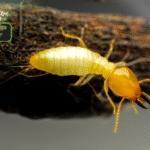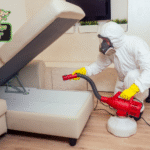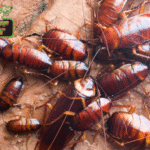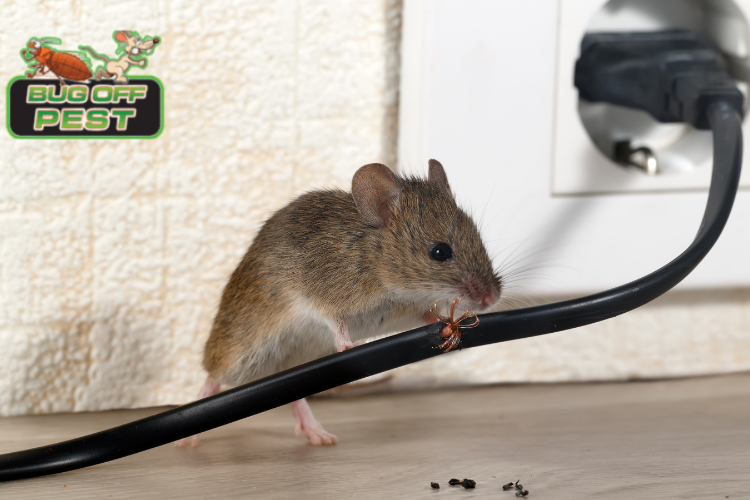Rodents like mice and rats may look small, but they can create serious problems for homes and businesses. One of the most dangerous issues is their habit of chewing on electrical wiring. This behavior is more than an inconvenience because it can lead to safety risks, fire hazards, and expensive repairs.
When rodents damage wires in attics, walls, or equipment, the warning signs are often hidden. Problems usually show up only after something breaks or stops working. This is why understanding how rodent damage begins and how it affects your property is so important. A quiet infestation can compromise the safety of your building, making early awareness and prevention a priority.
It’s vital to understand that Rodents Damage not only your wiring but can also lead to electrical fires and costly repairs. Being proactive in preventing rodent infestations is key to protecting your property from Rodents Damage.
Why Rodents Chew on Electrical Wiring
Have you ever wondered why rodents seem so drawn to your home’s wiring? It’s not a random act. These critters have specific reasons for targeting electrical wires, turning a simple pest problem into a significant safety hazard. This destructive behavior stems from both biological needs and instinct.
Understanding this attraction is key to preventing a rodent infestation from escalating. Whether it’s the texture of the wires or their instinct to chew on various objects, the risk of rodent damage to your electrical system is real. Let’s look at the main reasons behind this dangerous habit.
Instinctive Need to Gnaw and Tooth Growth
A primary reason for this destructive behavior is rooted in the biology of rodents. The incisor teeth of rats, mice, and squirrels never stop growing. To keep their teeth at a manageable length and properly sharpened, they have a constant, instinctive need to gnaw on hard or semi-hard objects. This isn’t a choice; it’s a matter of survival for them.
This relentless gnawing is a key indicator of rodent activity. If their teeth grow too long, it can prevent them from eating, leading to starvation. Electrical wires, with their plastic or rubber coating, offer the perfect resistance to help wear down their teeth effectively.
Unfortunately, your home’s wiring becomes an easy and accessible target. When you find signs of rodent presence, such as shredded materials or gnaw marks, it’s often linked to this natural instinct. An infestation means this chewing activity is happening constantly, often in hidden places like walls and attics.
Attraction to the Material and Heat of Wires
Beyond their need to gnaw, rodents are also drawn to the materials used for electrical wires. The soft plastic and rubber insulation surrounding the wires provide a satisfying texture for chewing. It’s durable enough to grind their teeth but soft enough to chew through without too much effort.
Another factor is their nesting instinct. Rodents often shred the insulation from electrical wires to use as soft, warm material for building their nests. If you find a nest made of shredded plastic or fibers, it could be from your home’s wiring. This not only damages the wires but also creates a fire hazard by placing flammable nesting material near potentially exposed electrical currents.
Finally, active electrical wires generate a small amount of heat, which can be an attraction for rodents seeking warmth, especially in colder months. This warmth, combined with the ideal chewing texture, makes wiring a prime target when rodents are searching for shelter and nesting spots, far more than other available food sources.
The risk of Rodents Damage escalates if these pests are allowed to invade your home unchecked. This behavior can result in significant electrical issues, necessitating immediate action.
Types of Rodents That Damage Electrical Wiring
Awareness of which rodents are most likely to cause Rodents Damage can aid in early detection and effective pest control strategies.
Not all rodents are created equal when it comes to the threat they pose to your property. Certain types of these pests are notorious for causing significant electrical damage. The most common culprits found in homes and businesses are mice, rats, and squirrels, each contributing to the problem in their own way.
Knowing which rodent is responsible for the activity can help inform the best course of action for removal and prevention. Their behaviors and nesting habits differ, which can influence where you might find damage. Next, we’ll identify the most common offenders and how their habits differ.
Common Household Rodents (Mice, Rats, Squirrels)
The three primary culprits behind wiring damage are mice, rats, and squirrels. Each of these pests can infiltrate your property through small entry points, leading to a full-blown rodent infestation if not addressed quickly. Mice, due to their small size, can squeeze through dime-sized holes, while rats need an opening about the size of a quarter.
Squirrels, on the other hand, are excellent climbers and often gain access through the roof, vents, or eaves. Once inside, all three species will gnaw on wires they encounter in attics, basements, crawl spaces, and within walls. This behavior is not just destructive but also creates serious safety risks for homeowners.
Differences in Behavior Among Rodent Species
The behavior of these rodent species varies, which can help you identify the type of infestation you’re dealing with. Mice are naturally curious and will explore new objects in their territory, which often includes traps and bait stations. They tend to build nests close to food sources and can create large populations quickly.
Rats, particularly Norway rats, are more cautious and wary of new things in their environment, a behavior known as neophobia. This can make them harder to trap. They are excellent burrowers and are often found in basements and crawl spaces. Their gnawing power is much stronger than that of mice, allowing them to cause more significant damage in less time.
Squirrels exhibit very different behavior. As natural climbers, they typically inhabit attics and high-up spaces. They are most active during the day, so you might hear scratching or scurrying noises above you in the morning or afternoon. Effective pest control strategies must account for these unique behaviors to successfully manage an infestation and prevent jejich return.
How Rodents Physically Damage Wiring
Rodents don’t just nibble on wires; they cause specific physical damage that compromises the entire electrical system. Their sharp incisors are strong enough to strip away the protective wire insulation, leaving the live metal conductor exposed. This is the primary way they create electrical hazards.
The signs of rodent activity on wiring can range from minor scratches to wires being chewed completely in two. This rodent damage is a direct threat to your property’s safety. Let’s explore exactly how they chew through these components and what it means for the surrounding electrical system.
Chewing Through Insulation and Wires
The most direct form of rodent damage is the act of chewing. When a rodent gnaws on electrical wires, it starts by stripping away the plastic or rubber insulation. This protective coating is designed to prevent the electrical current from coming into contact with other materials. Once it’s gone, the live wires are left exposed.
This exposed wiring is incredibly dangerous. If two exposed wires—a positive and a negative—touch, it can cause a short circuit. Even if only one wire is exposed, it can come into contact with other conductive materials like metal pipes, screws, or even pools of water, creating a serious risk of electrical shock or fire.
In some cases, the chewing интенсивность can be so severe that rodents sever the wire completely. This will cause an immediate power failure in that circuit, leading to outlets or lights ceasing to work. This type of electrical damage is a clear sign that rodents have been active in your walls, attic, or crawl space.
Impact on Surrounding Electrical Components
Damage to electrical wiring caused by rodents often extends to surrounding electrical components. They can chew through insulation, leading to exposed wires that create a risk of short circuits and electrical fires. This unseen damage can disrupt power supply to appliances and result in costly repairs for homeowners. Signs of rodent activity, such as droppings or visible bite marks, highlight the necessity for immediate action. Investing in pest control in North Port and rodent control in North Port helps mitigate these risks effectively.
Signs of Rodent Damage to Electrical Systems
Identifying the signs of Rodents Damage early can help you minimize the risk of severe electrical issues that can compromise your safety.
How can you tell if rodents have been tampering with your electrical system? Often, the signs of rodent activity are subtle at first but can escalate into major problems. You might notice issues with your home’s power or find physical evidence of the pests themselves.
Recognizing these signs early is crucial to preventing severe electrical damage, power outages, and potential fires. There are two main categories of indicators to watch for: visual evidence left by the rodents and functional problems with your electricity. We will examine both of these categories in more detail.
Visual Indicators (Chewed Wires, Droppings, Nests)
One of the most reliable ways to confirm a rodent problem is by finding physical evidence. During an inspection of your attic, basement, or crawl spaces, you should look for clear visual signs of their presence. These indicators are often found near walls, behind appliances, and along pathways rodents use to travel.
Chewed wires are the most direct sign of electrical damage. You may see visible bite marks, shredded insulation, or wires that are completely gnawed through. Alongside this, you will likely find droppings. Rodent droppings are small, dark pellets, and their presence is a definite indicator of an active infestation.
Finally, look for nests. Rodents build nests from soft, shredded materials. If you find a small pile of shredded paper, fabric, or insulation, it’s a strong sign that rodents are living in your home. Key visual signs include:
Gnaw marks or visible bite marks on wires and cables.
Small, dark rodent droppings, especially along walls or near food sources.
Nests made of shredded paper, insulation, or other materials.
A strong, musky odor from urine in enclosed areas.
Electrical Issues (Flickering Lights, Power Outages)
If you suspect Rodents Damage, seek professional help immediately to avoid further complications.
Sometimes, the first clue of rodent damage comes from problems with your electricity. If your home’s wiring has been compromised, it can lead to a variety of unexplained electrical issues. These problems occur because the flow of electricity has been disrupted by chewed or broken wires.
Do your lights flicker for no apparent reason? Do your circuit breakers trip frequently? These are classic signs that there might be a short circuit somewhere in your system, удовольствия caused by exposed wires. You might also experience partial power outages, where certain outlets or rooms suddenly stop working.
While these symptoms can have other causes, they are a significant red flag when combined with any visual signs of rodents. Ignoring這些 electrical problems increases the risk of rodent damage leading to a more serious event, like an electrical fire. If you notice these issues, it is time to investigate further.
Electrical Risks and Safety Hazards from Rodent Damage
Understanding the risks associated with Rodents Damage to your electrical systems is essential for maintaining a safe home.
The damage rodents cause to wiring goes beyond simple inconvenience. It creates serious electrical risks and safety hazards that can endanger your family and your property. Exposed wires are a recipe for disaster, capable of causing short circuits, which can lead to devastating consequences.
The primary dangers are electrical fires and the risk of shock. When the protective insulation is gone, the electrical current is no longer contained, making your home’s structure and its occupants vulnerable. The following sections will detail these specific hazards and explain why they are so dangerous.
Fire Hazards Due to Exposed Wires
These electrical hazards are compounded by the potential for Rodents Damage, which can escalate to life-threatening situations.
The single greatest danger रियल with rodent-damaged wiring is the risk of electrical fires. When rodents chew through insulation, they expose the live metal wire inside. If this exposed wire touches another damaged wire or a conductive surface like a metal pipe, nail, or ductwork, it creates a short circuit.
This short circuit can generate intense heat and sparks, a phenomenon known as arcing. These sparks can easily ignite surrounding materials. Since rodents often nest in hidden, enclosed spaces like attics and walls, any spark can quickly set fire to flammable materials such as wood framing, insulation, or the rodents’ own nests made of paper and other debris.
These electrical fires are particularly dangerous because they often start invisibly within walls, giving the fire time to grow before it’s detected. According to the National Fire Protection Association, electrical failures or malfunctions are a leading cause of home fires, and rodent damage is a significant contributing factor.
Risk of Electrical Shock and Equipment Failure
Beyond fire, exposed electrical wires create a direct risk of electrical shock. If a person or pet comes into contact with a live wire that a rodent has chewed, the result can be a severe or even fatal shock. This danger is especially high in areas like basements or crawl spaces, where wiring might be more accessible.
Damaged wiring also leads to equipment failure. The inconsistent flow of power from shorting or frayed wires can damage the sensitive electronics in your appliances. This can cause them to malfunction or break down completely, leading to expensive replacement costs. You may notice:
Appliances that turn on and off unexpectedly.
Devices that no longer work when plugged into certain outlets.
A buzzing or sizzling sound coming from outlets or switches.
These issues are not just inconvenient; they are warnings of a compromised electrical system. Never attempt to handle or repair damaged wires yourself. Always seek professional assistance to avoid injury.
The consequences of Rodents Damage include not only malfunctions but also the risk of electrocution for pets and people alike.
Immediate Steps if You Suspect Rodent Damage
Act quickly if you notice any signs of Rodents Damage to ensure the safety of your electrical system and your home.
If you see signs of chewed wires or are experiencing unexplained electrical issues, you must take immediate action. Suspected rodent damage to your electrical system is an emergency that requires a swift and safe response to protect your property and everyone in it. Your first priorities should be safety and assessment.
Do not attempt to fix the wiring yourself. The combination of a live electrical current and an active rodent problem is a dangerous one. Instead, follow a clear set of steps to secure the area and call in professionals, including both a pest control expert and an electrician.
Shutting Off Power and Assessing the Area
The very first step is to eliminate the immediate danger. Go to your home’s main electrical panel and shut off the power to the area where you suspect the damage. If you are unsure which circuit is affected, it is safest to turn off the main breaker, which cuts power to the entire house. This is the best way to prevent a fire or electrical shock.
Once the power is off, you can perform a cautious visual inspection. Using a flashlight, check accessible areas like your attic, basement, and behind large appliances. Look for the telltale signs of rodent activity, paying close attention to the condition of your home’s wiring. This is the first place to start your assessment.
During your inspection, be on the lookout for:
Gnawed or frayed wires and cables.
Rodent droppings or urine stains near electrical components.
Nesting materials tucked into corners or behind equipment.
Remember, this is only a visual check. Do not touch or move any damaged wiring.
Temporary Safety Measures Before Repairs
While you wait for professional help, it’s important to take temporary safety measures. The primary goal is to prevent anyone from accidentally coming into contact with a hazardous area. Keep children and pets away from the locations where you found damage, such as basements or crawl spaces.
If possible, block access to these areas. You should also avoid plugging in or using any appliances on the circuits you suspect are damaged, even if you have to temporarily restore power to other parts of the house. This reduces the risk of rodent damage causing further harm to your equipment or starting a fire.
Do not attempt any DIY repairs. Electrical work is complex and dangerous, and damaged wiring from rodents presents unique challenges. The only safe solution is to wait for a licensed electrician to assess the situation and perform a proper repair. These measures will help keep your home safe until the experts arrive.
Professional Inspection and Repair of Damaged Wiring
Dealing with rodent-damaged wiring is a two-part problem that requires two types of experts: a professional pest control service and a licensed electrician. An electrician is needed to safely handle the electrical repairs, while a pest control company will address the root cause of the problem—the rodents themselves.
A thorough inspection is the first step in this process. Professionals have the training and tools to identify the full extent of the damage and create a plan for repair and prevention. Simply fixing the wires without eliminating the pests will only lead to recurring issues.
Addressing Rodents Damage is a priority for any homeowner to ensure safety and prevent costly repairs.
What Electricians Look For During Inspection
When a licensed electrician conducts inspections for rodent damage, they are looking for more than just a single chewed wire. They perform a comprehensive assessment of your electrical system to identify all points of failure and potential hazards. Their goal is to ensure the entire system is safe, not just to patch one problem.
Electricians will trace the affected circuits to find all areas of rodent damage, which may be hidden deep within walls or ceilings. They look for exposed conductors, severed wires, and signs of arcing or overheating, such as scorch marks on wood or melted plastic. They also check junction boxes and outlets for nests and droppings.
Regular inspections by a professional are a valuable preventive measure. During an inspection, an electrician will look for:
The extent of the damage to the wiring and insulation.
Evidence of short-circuiting, such as burnt or melted components.
Nesting materials or debris packed around electrical boxes that could pose a fire risk.
Preventing Rodent Damage to Electrical Systems
The best way to deal with rodent damage is to stop it before it starts. Implementing proactive rodent control measures is far safer and more cost-effective than dealing with the aftermath of an infestation. Preventive measures focus on making your property less attractive and accessible to pests. Understanding how Rodents Damage your electrical system is crucial. This involves a combination of sealing your home, removing attractants like food sources, and using deterrents. A comprehensive pest control plan can safeguard your electrical system from these destructive critters. Let’s explore the most effective strategies for keeping rodents out and preventing Rodents Damage.
Regular Maintenance and Monitoring Practices
Prevention is an ongoing process, not a one-time fix. Regular maintenance and monitoring are essential to keeping your home rodent-free. Make it a habit to periodically inspect your attic, basement, and crawl space for any new signs of activity, such as droppings or gnaw marks. Catching a problem early is key to minimizing the risk of rodent damage.
These inspections allow you to identify and seal new entry points that may have appeared over time. It’s also a good practice to keep your property tidy and free of clutter, as piles of boxes or debris provide perfect hiding spots and nesting areas for rodents.
For the highest level of protection, consider a professional pest control plan. Experts in Rodent Control in North Port can provide regular inspections and maintain deterrents and traps around your property. A service like Pest Control in North Port from Bug Off Pest ensures that your home is continuously monitored by trained technicians who can spot and address vulnerabilities before an infestation takes hold.
Regular inspections can help catch Rodents Damage early, preventing extensive harm to your electrical systems.
Sealing Entry Points and Reducing Attractants
Implementing preventive measures against Rodents Damage is essential in safeguarding your home from future infestations.
Rodents can get into your home through surprisingly small openings. The most important step in prevention is to conduct a thorough inspection of your property’s exterior and seal any potential entry points. Pay close attention to gaps in the foundation, openings around pipes and utility lines, and damaged vents.
Use durable materials for sealing. A combination of steel wool and caulk is highly effective, as rodents can’t chew through the steel and the caulk holds it in place. You should also ensure that food is not left out. Store pantry items in airtight containers, clean up spills promptly, and keep pet food and garbage in sealed bins.
Removing這些 attractants makes your home a less appealing target. Some homeowners also use natural deterrents like peppermint oil, which can be unpleasant for rodents. Key prevention steps include:
Sealing cracks and holes larger than a quarter-inch with steel wool and caulk.
Covering vents and chimneys with mesh screens.
Keeping food stored in rodent-proof containers.
Trimming tree branches away from the roofline.
Frequently Asked Questions
Yes, absolutely. When rodents chew through insulation, they expose live wires. These can create sparks or short circuits that ignite nearby flammable materials like wood, insulation, or nesting debris. This type of rodent damage is a leading cause of dangerous electrical fires in homes and businesses.
The best prevention method is sealing all potential entry points into your home using materials like steel wool and caulk. Removing food and water sources also makes your property less attractive. Using deterrents and consulting with pest experts for a comprehensive plan can provide complete protection.
A licensed electrician conducts a detailed inspection, often using specialized tools to check wiring inside walls. They look for signs like droppings, gnaw marks, and nests near electrical components. Regular inspections can help find visible bite marks and other evidence before the damage becomes severe.







